TRADE AXE & TOMAHAWK COLLECTORS ASSOCIATION. | home
ABOUT T.A.T.C.A. | FORUM | MY humble COLLECTION | MEMBER'S AXES | PAGE ONE | PAGE TWO | PAGE THREE | PAGE FOUR | PAGE FIVE | PAGE SIX | PAGE SEVEN | PAGE EIGHT | PAGE NINE | PAGE TEN | PAGE ELEVEN | PAGE TWELVE | FAMOUS TOMAHAWKS | COWAN'S | EBAY RAMBLINGS | MORE EBAY STUFF | The MYSTERY PAGE | LINKS | BUY- SELL | WHAT IS A TOMAHAWK? | SUGGESTED READING | FOUND | FOREIGN AXES | BOARDING AXES | THANK YOU FOR JOINING T.A.T.C.A | WHO USED "TOMAHAWKS"? | OPINION / REVIEW BOARD | MIMICS AND other WEIRD AXE | ARTIFAKES & GALLERY OF REPROS | YOU BE THE JUDGE. | MODERN BLACKSMITH AND OTHER TOMAHAWK ART
From TATCA member Mike in Ohio comes photos of his outstanding
collection, quite a few of which are Ex-Robert Kuck collection.
Thanks Mike.
NEZ PERCE PIPE TOMAHAWK Circa: 1850 - 1900
(Chief John Moses, his tomahawk)
It is rare to find a tomahawk that can be linked to a certain individual
and rarer still to have a vintage picture of that person holding it. Nez
Perce Chief John Moses, a relative of the famous Nez Perce leader Chief
Joseph, owned this Plains Indian tomahawk.Cast steel head with brass
tacked haft. This pipe tomahawk has a 1 1/4” oval eye. The pipe bowl
rises on its chevron-base pedestal to a height of 1 5/8”. The straight-sided
bowl opening is 11/16” wide and is flat bottomed. There is a ridge molding
at the base and a slight edge molding at the top. Casting lines cam be seen
on the bowl. The obverse side of the blade is decorated with seven tally
marks on the top edge and three engraved lines forming a split pyramid
design on the face. These lines converge at the top ridge and carry over
and down the reverse side as a single line which is dissected by a
second forming an X.. The lower edge of the blade gracefully curves towards
the eye creating the thin wasted blade style of the period. The hard wood
haft is octagonal displaying seventy-five square shanked brass tacks in
four rows of nineteen each (one missing). Three of the tacks around the incorporated mouthpiece are of a smaller size. The fore end of the
helve is decorated with an additional four tacks. Red ochre is visible
on the haft just below the eye.
Height: 7 1/2” Width: 2 1/4” Length: 21 1/2” Length below the eye: 20 1/4”
Pictured in TOMAHAWKS-PIPE AXES-OF THE AMERICAN FRONTIER by John Baldwin 1995, page 117 fig. 307, 308, 309.
Ex. Alderman collection Pendleton, Oregon.
Background: Duane Alderman of Pendleton, Oregon purchased this
tomahawk from Alan Slickpoo, a Nez Perce NEPTIC, high in the tribal
council. It has been past down in the family for generations,
accounting for its pristine condition.
Below
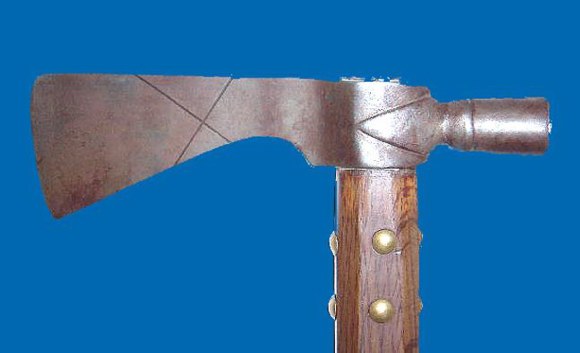
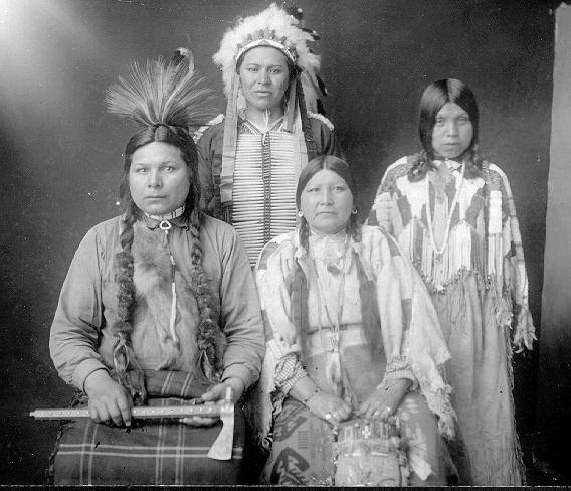

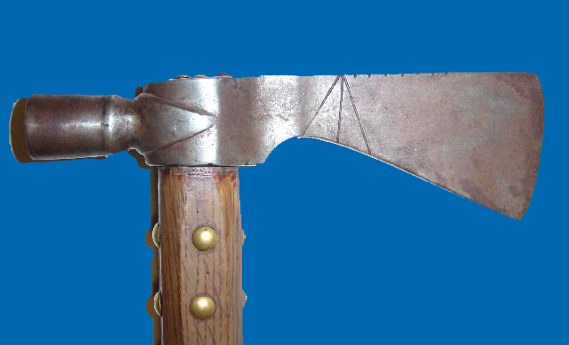
MID-WESTERN PIPE TOMAHAWK Circa 1860 - 1880
(original haft)
This Midwestern transitional pipe tomahawk from Minnesota,
has all the characteristics of the larger western specimens.
The headis hand forged steel. The tall barrel shaped bowl
has upper and lower moldings rising 1 5/8" from the poll.
The pointed chevron is scratch (engraved) decorated at the V.
The eye is a diamond with a sharp median ridge with line filing ////
decoration. There are three filed moldings at the junction of the
blade and eye, with a small projection at the blades rear. The flared
blade has circularraised, silver metal disc inlays on both sides.
One side (obverse) of the inlay has a dot surrounded by five small lines.
The reverse inlay has a dot surrounded by twelve lines
(possibly a sun representation). Hafting is hand done, completely
file branded and covered with red pigment. Sixty-eight (68) brass
tacks decorate the ash wood haft with the smoke hole burned
through the pith. There is a drop piercing 4 3/4" from the butt.
The axe came from a collection of tomahawks and Indian artifact
that once hung in a saloon in Blue Earth Minnesota.
The US Cavalry were sent to Minnesota to quell the, Sioux
uprising and traded souvenirs from their expeditions for drinks.
Height: 7 7/8" Width: 3 1/8" Length: 18 1/2" Length below the eye: 17"
Ex. Andrew Myrick collection, owner of Myrick Trading Post.
Ex. Cort Collection, Baxter, Iowa
Below
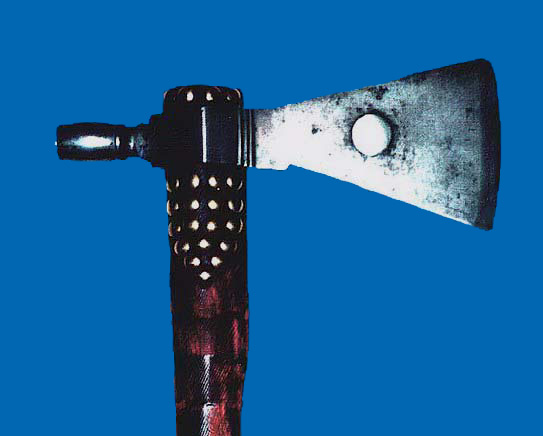
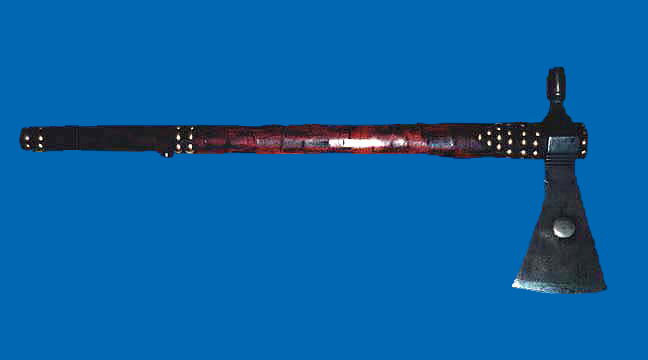
U.S. NAVAL BOARD AXE Circa 1812
(old haft)
Classical American boarding axe. Known as Type III. Single tooth,
formed by two wedge-shape cuts. The spike base and blade both have
fuller moldings as seen on many pipe tomahawks. The rectangular
flat spike is 3 3/4" in length terminating to a sharp point. The 4
7/8" blade is stamped with "US NYW JT". Inspected by Captain
Joseph Tarbell during the War of 1812 at the Navy Yard
Washington.
Height: 9 1/2" Width: 2 1/2" Length: 10 3.4"
The fact that the haft is short would suggest that the axe was used as a hand weapon.
Ex. Charles Micol collection Durham, North Carolina.
Below
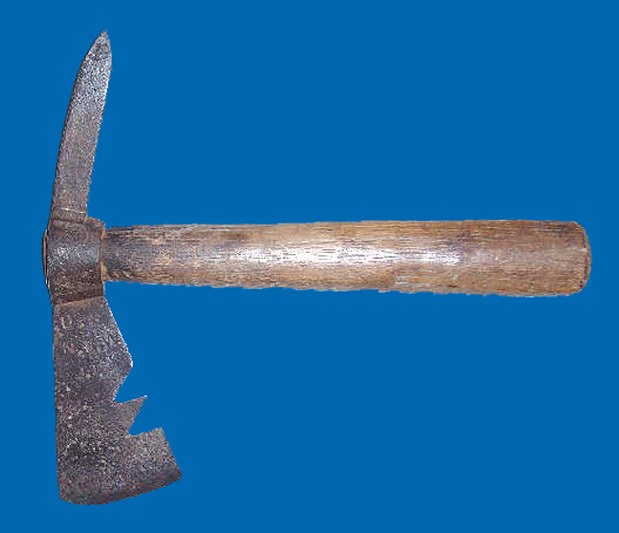
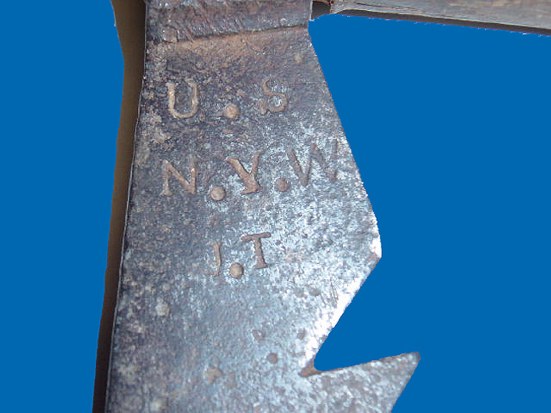
"TRADE" HALBERD Circa 1750 - 1770
(barbed)
As the Indian trade flourished better quality iron products
appear to have been introduced. This example has a round mounting
socket which could have been secured to a long or short staff.
Its barbed spear tip is rectangular in cross section and might have
seen use for fishing, fighting, or hunting. Found in upstate New York.
Height: 7" Width: 3 3/4" Length: 20" Spear: 11"
Ex. Cayla collection, Oklahoma.
See: Swords & Blades of the American Revolution by George C. Neumann 1973, page 206, 51.PA.
Below
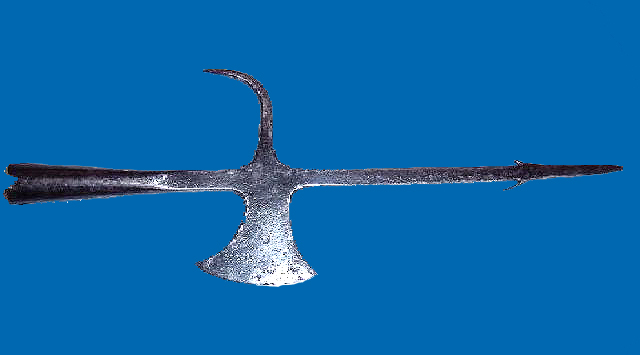
SPIKE TOMAHAWK Circa 1700 (original haft)
This Iroquois spiked tomahawk was found sticking out of
the bank along the Little Miami River by Kings Mills, Ohio just
below Muddy Creek. Mr. Scott Ellis was canoeing when he was
eighteen years old in 1958. He stopped along the river to rest,
when he saw the handle sticking out of the sandy bank by
his leg. Scott kicked it with his foot and the ax dislodged falling
at his feet. He placed it in the bottom of his canoe and took it home.
He cleaned the dirt off the relic and found that it was perfectly preserved.
The haft is a dark cherry, showing much use around the blackened,
grease stained lower handle. The ax is unique in that it has both a lower
and upper ear similar to mid-evil battle axes. The actual eye is a pointed
ellipse. It is small and light for running the animal trails of a wild forest.
The rakish 3/8" spike is square in design descending 2 3/4" to
a sharp point. The blade is beaver-tailed showing no sign of a steel edge.
The ax is hand forged from two pieces of wrought iron
Height: 7" Width: 2 9/16" Length: 13 3/4" Length below the eye: 11 3/4" Weight: 10 1/2 oz (300grams)
Ex. Scott Ellis and Ernest Back collections Tipp City, Ohio.
This spike axe was in an issue of Ohio Archaeologist magazine
Vol.48 NO.2 Spring 1998.
Below
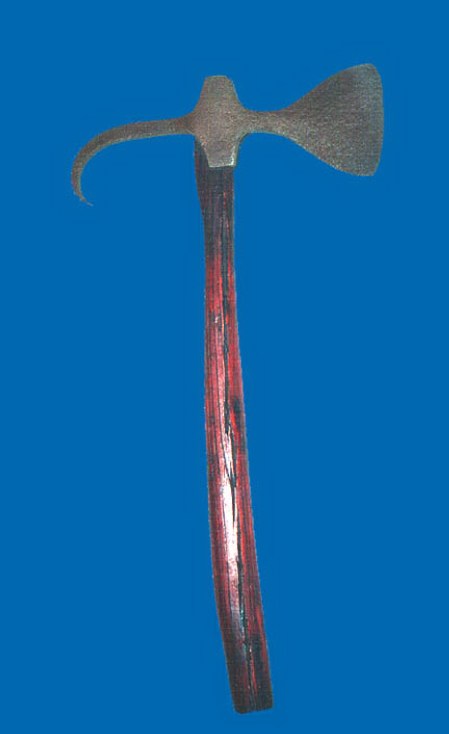
SPIKED TOMAHAWK Circa 1740 - 1760
(old haft)
This uniquely designed hand-forged tomahawk from the
Iroquoian woodland of New York State is in excellent condition.
The 3/4" eyeis round with four decorative vertical line decorations
on each side (two lines at the base of the blade and two at it's poll at the
baseof the spike platform). One single line is filed across the top of
the blade in front of the eye. The plane of the blade tapers in from
the eye and gracefully drops towards the heel. The downward flare of
the blade with its underside lobe, gives this tomahawk a wicked
ominous look. Three filed lines are cut across the bottom edge
of the blade, one at the eye and two 3/4" further down
towards the steel bit. The poll begins as a 7/8" rectangle
(much like a hammer poll), providing weight, balance and a base for
the reduced rectangular 1 3/4" spike, which tapers to a sharp point.
The spike has two filed lines around its circumference at its
midpoint. The hard wood helve is round and if not the original
an old replacement.
Height: 7 15/16" Width: 3 1/8" Length: 20 1/4" Length below the eye: 19 1/2"
Ex. Gerald Wynn collection, Parma, Ohio.
For a similar example see: AMERICAN INDIAN TOMAHAWKS by Harold L. Peterson
1971. #77, page 96.
Below
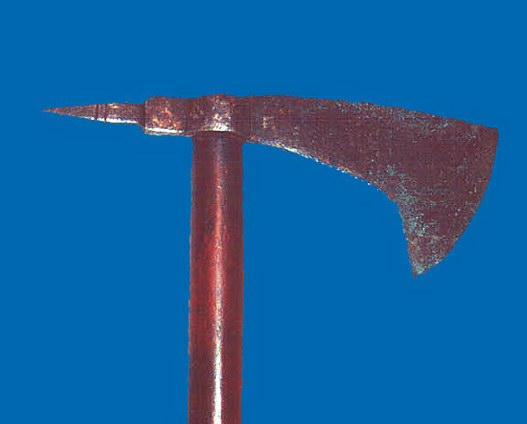
SPONTOON TOMAHAWK Circa pre 1800
(original haft)
"Spontoon" tomahawks were usually limited to fighting and
ceremonial use by the Indians of North America. The French
appear tohave furnished most of them. The primary purpose of this
spontoon war axe was to kill. The hand forged, triangular shaped blade
has been sharpened. The blade is pierced with two parallel holes
either for decoration or to assist with carrying. The eye is round
measuring 1 1/4" across. The head is hafted from the fore-end with
the wooden end recessed so the head could never accidentally
slip off.
Height: 9 3/4" Width: 2 1/4" Length: 24" Length below the eye: 22"
See: TOMAHAWKS, PIPE AXES by John Baldwin 1995, page 86.
Below
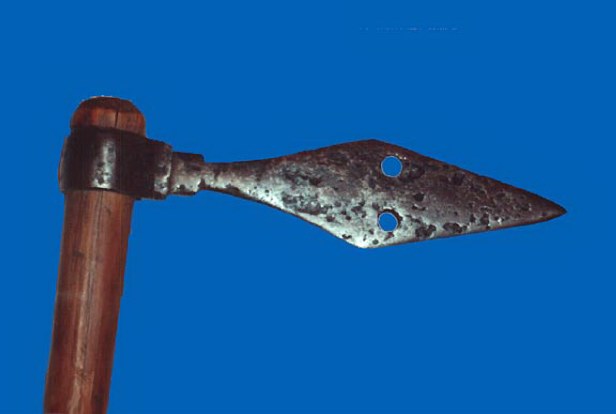
UNDERHILL SPIKE TOMAHAWK Circa 1852
(original handle)
Late spike tomahawk by the Underhill Edge Tool Company. It is made of
forged steel with an outline that resembles an earlier style
head. The side is flat with pyramid-shaped ears. The reverse side of the
blade is stamped UNDERHILL EDGE TOOL CO. The letter O is also stamped
on the reverse side. This O denotes that the ax is an early one for the
company. It has an old 13" hardwood haft with a lanyard hole in the butt.
The 2 3/8" spike is rectangular in design. The hole in the butt is
almost to large for a lanyard. It may have been used to hang the ax
from a peg or branch while dressing game etc.
Height: 7 1/4" Width: 3" Length: 13" Length from eye: 11 1/8"
Ex. Dale C. Anderson collection, Gettysburg, Pa.
See: Indian Tomahawks & Frontiersmen Axes by Hartzler & Knowles 1995 pages
249 and 254.
UNDERHILL EDGE TOOL CO. OF NASHUA N.H. 1852 - 1890 by Jerry Wynn
Parma, Ohio.
Below
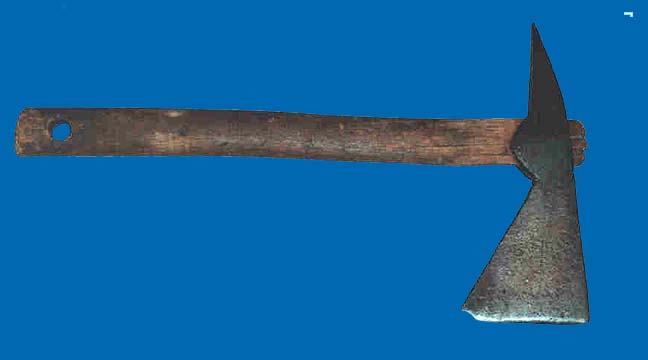
Back to the top
More of Mike's
